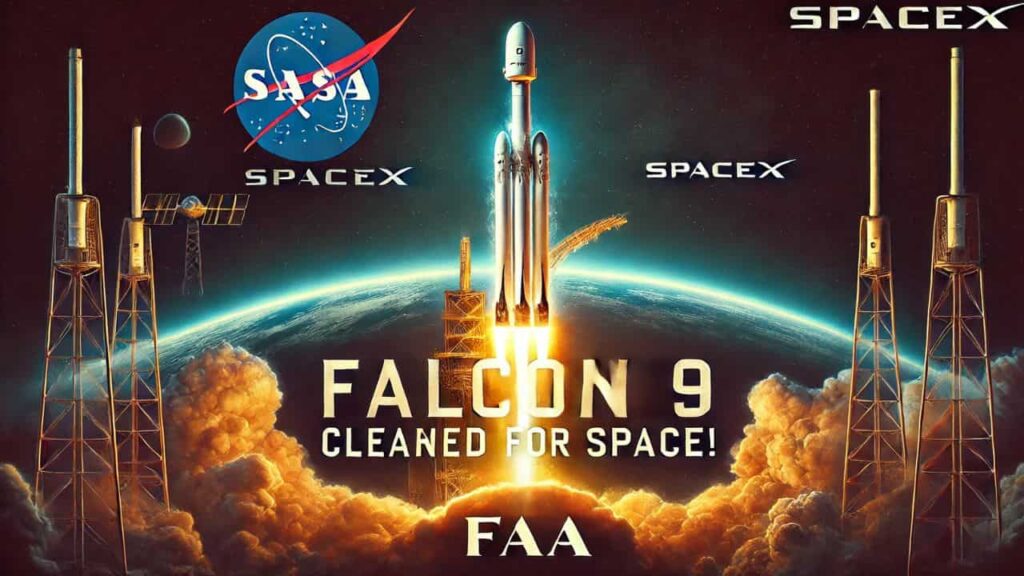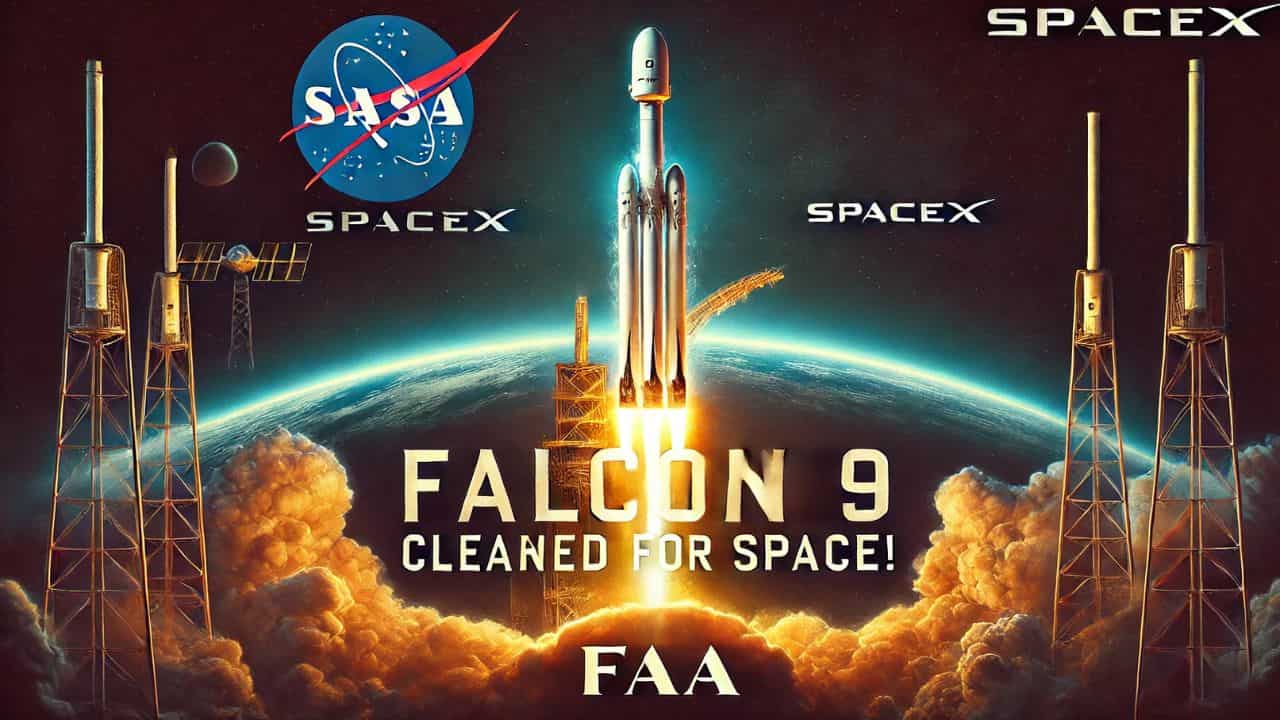SpaceX, Falcon 9, FAA clearance, spaceflight, rocket launch, Star link, NASA, Crew Dragon, space exploration
SpaceX’s Falcon 9 rocket has been cleared by the FAA to return to space after a rare mid-flight failure. Discover the details of the incident, SpaceX’s response, and the future of this critical rocket in space exploration.

SpaceX’s Falcon 9 Cleared to Return to Space by FAA
SpaceX’s Falcon 9 rocket, the cornerstone of modern space exploration, has been given the green light to return to flight operations by the Federal Aviation Administration (FAA). This clearance comes after a rare mid-flight failure that temporarily grounded the rocket. The FAA’s decision is a significant step forward for SpaceX and the broader space industry, as Falcon 9 has been a reliable workhorse for space missions over the past decade.
The Incident: A Rare Anomaly
The mid-flight failure occurred on July 11, 2024, during a routine mission to deploy a batch of Starlink satellites. This incident marked the first failure of the Falcon 9 in over seven years. During the launch, one of the rocket’s stages broke apart in space, resulting in the loss of its payload of Starlink satellites. This anomaly was a stark reminder of the inherent risks of space travel and the importance of rigorous safety protocols.
FAA’s Investigation and Clearance
Following the incident, the FAA launched an investigation to determine the cause and ensure there were no public safety concerns. On Thursday, the FAA announced that it had found no public safety issues related to the anomaly. Consequently, they cleared the Falcon 9 to resume flight operations while the investigation into the root cause of the failure continues.
SpaceX’s Response
In a post on X (formerly known as Twitter), SpaceX expressed readiness to return the Falcon 9 to flight as early as Saturday, July 27. SpaceX provided a detailed explanation of the anomaly, identifying a liquid oxygen leak that led to excessive cooling of one of the engine components, which in turn caused hardware damage. The company pinpointed a crack in a sense line for a pressure sensor as the root cause of the leak. In response, SpaceX has decided to remove the failed sense line and sensor on the second stage engine for near-term launches.
Importance of Falcon 9
The Falcon 9 is renowned as the world’s most used rocket, playing a crucial role in both commercial and governmental space missions. Its reliability and reusability have revolutionized the space industry, significantly reducing the cost of access to space. The rocket’s versatility allows it to carry a wide range of payloads, including satellites, cargo, and human crews.
NASA’s Upcoming Missions
Falcon 9 is the only U.S. rocket currently capable of sending NASA crews to the International Space Station (ISS). The rocket is integral to NASA’s human spaceflight program, with the Crew Dragon astronaut capsule launching atop the Falcon 9. NASA has a scheduled astronaut mission in August, underscoring the urgency of getting Falcon 9 back in operation.
The Starlink Project
One of the most ambitious projects undertaken by SpaceX is the Starlink satellite constellation, aimed at providing global high-speed internet coverage. The recent anomaly resulted in the loss of a batch of these satellites, highlighting the challenges and risks associated with large-scale space missions. Despite the setback, SpaceX remains committed to rapidly deploying the constellation, which already includes thousands of satellites in orbit.
SpaceX’s Commitment to Safety
Safety is paramount in space exploration, and SpaceX has demonstrated its commitment to identifying and rectifying issues promptly. The company’s ability to quickly diagnose the cause of the anomaly and implement corrective measures showcases its technical prowess and dedication to maintaining high safety standards. This proactive approach is crucial for the continued success and reliability of the Falcon 9 rocket.
The Future of Falcon 9
With the FAA’s clearance, the Falcon 9 is poised to continue its pivotal role in space missions. The rocket’s ability to safely and efficiently transport a variety of payloads makes it indispensable to both commercial enterprises and governmental agencies. As SpaceX continues to innovate and refine its technology, the Falcon 9 will likely remain a cornerstone of space exploration for years to come.
Conclusion
The FAA’s decision to clear the Falcon 9 for return to flight operations marks a significant milestone for SpaceX and the global space industry. Despite the setback of the mid-flight failure, the swift investigation and resolution demonstrate SpaceX’s resilience and commitment to safety. The Falcon 9’s return to service will enable the continuation of critical missions, including NASA’s upcoming astronaut launch and the ongoing deployment of the Starlink constellation. As SpaceX looks to the future, the Falcon 9 will undoubtedly remain a key player in the quest to explore and utilize space.
Key Takeaways
- FAA Clearance: The FAA has cleared SpaceX’s Falcon 9 to return to flight after a thorough investigation found no public safety issues related to the recent anomaly.
- Incident Details: The mid-flight failure on July 11 resulted from a liquid oxygen leak caused by a cracked pressure sensor line, leading to the loss of a Starlink satellite payload.
- SpaceX’s Response: SpaceX has identified and addressed the issue, preparing to return the rocket to flight operations.
- Falcon 9’s Role: As the world’s most used rocket, Falcon 9 is critical for a variety of missions, including NASA’s human spaceflight program and the Starlink satellite constellation.
- Future Missions: The Falcon 9 is set to continue its vital contributions to space exploration and satellite deployment, with upcoming missions including a NASA astronaut launch in August.
Final Thoughts
The resilience and adaptability of SpaceX in addressing and overcoming technical challenges are testaments to the company’s leadership in the space industry. As Falcon 9 prepares to soar again, it symbolizes not just a return to routine operations but also the ongoing pursuit of innovation and excellence in space exploration. The lessons learned from the recent anomaly will undoubtedly contribute to even greater safety and reliability in future missions, reinforcing the Falcon 9’s status as a cornerstone of modern spaceflight.
Read More
- NASAs Perseverance Rover Finds Potential Signs of Ancient Life on Mars
- NASA Releases Groundbreaking 2024 Civil Space Shortfall Ranking
- NASA Missy Elliott: Hip-Hop Song Beamed to Venus
- NASA Invites Media to Northrop Grumman 21st Station Resupply Launch










